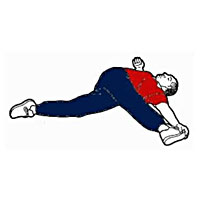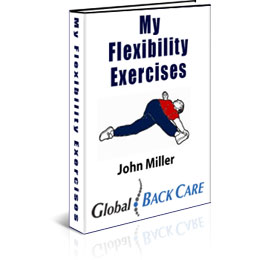
Throughout the second half of the 1990s I had lower back pain. Every time I sneezed or coughed it felt like someone was ramming a red hot poker into my back.
I blamed the rowing machine. Wrong!
Like most people with lower back pain, the incident accounts for a small fraction of the problem, the top of the tip of the iceberg.
Overt the weeks, months years and decades, the pelvis and the bones above it gradually move out of alignment. You don’t notice it.
But gradually you’re moving closer and closer to the back pain cliff. Then all of a sudden, BAMMO along come an incident that people in good musculo-skeletal health take in their stride. You get tipped over the edge.
That’s what happened to me.
Here’s what I did to relieve the pain.
Between late November 1994 and September 2000 I was doing a strength and flexibility routine but it was not sufficient to completely fix the problem. Whilst the pain went from 10/100 up to about 70/100, (0/100 being dreadful and 100/100 being perfect condition) it still hurt when I sneezed and coughed. I thought that that was as good as it was going to get. Wrong again.
Just after the Sydney Olympics I started doing a better routine. Initially I spent two hours each evening in front of TV doing the full suite of exercises outlined in my Fix Back Pain ebook. By the end of November 2000, the stabbing pain had disappeared and it hasn’t come back.
Once the pain had gone, I gradually worked out a shorter routine which I now do after a strength training workout at the gym – which is, on average, three times a week. The routine takes about 15 minutes.
The problem
For most people with lower back pain, the cause of the problem is a pelvis that’s out of alignment. When the pelvis moves out of alignment the bones immediately above it move out of alignment ‘in sympathy’.
When the vertebrae move, ligaments, tendons and muscles attached to them are stretched beyond their pain threshold and discs begin to herniate. When you sneeze and cough and a sliver of disc pushes into your spinal cord it hurts like hell.
The cause of the problem
In the sit down culture, the reason why the pelvis moves out of alignment is because some of the muscles attached to it are pulling it out of alignment. It’s usually tight hamstring and buttock muscles, though other muscles may be involved, like hip flexor and quadriceps muscles. Usually bet on tight hamstring and buttock muscles as being the main culprits.
It’s not difficult to work out which muscles are too tight. In fact you’ll find out which ones when doing the exercises in this ebook. Chances are it could be all of them.
The solution
The solution to lower back pain is loosening off tight muscles, particularly tight hamstring and buttock muscles. Rubbing and crunching the sport where it hurts isn’t going to treat the cause of the problem.
If you’d like a copy of My Flexibility Routine, click on the book cover.

